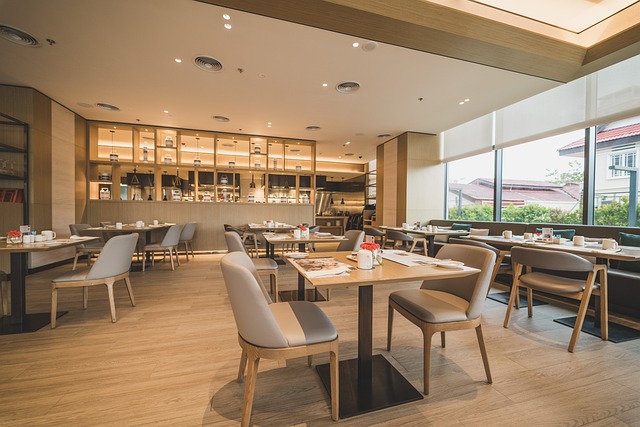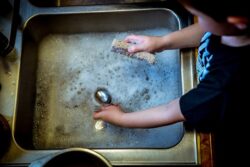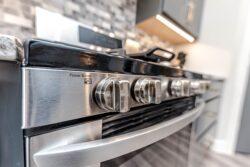
Welcome to the world of delicious treats and cozy dining areas! But have you ever wondered what really makes a restaurant special? It is not just about the food; it is also about a spick and-span environment that gives your dining experience that extra touch of magic! In this guide, we are going to reveal the methods used to keep a restaurant spotless so that every customer enjoys flavors as well as a safe and hygienic atmosphere. From the kitchen to the dining area, let us take a tour to learn the simple yet crucial procedures that ensure a restaurant’s dedication to cleanliness.
We will break down the significance of restaurant cleanliness in our guide. It is not just about meeting regulations; it is about creating an atmosphere where customers feel valued and where employees thrive. A clean restaurant is not a luxury; it is a fundamental aspect of providing a dining experience that leaves a lasting positive impression. Consider your favorite restaurant, the one where you always feel comfortable and cared for. Chances are, it is not just the menu that draws you in; it is the overall cleanliness and orderliness that makes you want to return.
Let us now explore the kitchen, which is the center of every restaurant. It is not only where mouthwatering dishes are created, but it is also the hub for preserving hygiene. We will cover the best practices for kitchen cleanliness, from routine equipment maintenance to appropriate waste management. Small actions like making sure dishes are spotless and ingredients are stored properly go a long way toward creating a kitchen that not only serves delicious food but also maintains the highest standards of hygiene. So, whether you own a restaurant or just enjoy going out to eat, join us as we explore the straightforward but crucial realm of restaurant cleaning for a hygienic dining experience!
See also our post on Restaurant Kitchen Cleaning: Maintaining Hygiene Standards
The Importance of Restaurant Cleanliness
Customer Well-being
A clean restaurant is a healthy restaurant. Prioritize the well-being of your customers by maintaining a spotless environment. A clean dining space not only leaves a positive impression but also safeguards customers from potential health risks.
Regulatory Compliance
Adhering to cleanliness standards is not just a choice; it’s a legal requirement. Familiarize yourself with local health and safety regulations. Complying with these standards not only ensures the longevity of your business but also establishes trust with authorities and customers alike.
Positive Customer Experience
Cleanliness contributes significantly to the overall dining experience. From sanitized tables to gleaming floors, a well-kept restaurant creates a positive and memorable impression. Satisfied customers are likely to return and recommend your establishment to others.
Employee Morale and Productivity
A clean restaurant is not only welcoming for customers but also uplifting for employees. A tidy workspace enhances employee morale and productivity. By providing a clean and organized environment, you foster a positive atmosphere that reflects in both customer service and food quality.
Reputation Management
Word of mouth can make or break a restaurant. A reputation for cleanliness is a powerful marketing tool. Positive reviews about the cleanliness of your establishment contribute to building a stellar reputation, attracting new customers and retaining loyal ones.
Kitchen Cleaning Best Practices
Regular Equipment Cleaning
Regularly clean and sanitize kitchen equipment to prevent the build-up of grease, grime, and bacteria. Pay special attention to areas like grills, ovens, and deep fryers. A clean kitchen ensures the production of safe and hygienic food.
Thorough Food Preparation Area Cleaning
Maintain a spotless food preparation area to guarantee the safety of every dish served. Clean and sanitize countertops, cutting boards, and utensils after each use. This practice reduces the risk of cross-contamination and ensures the freshness of ingredients.
Proper Storage Hygiene
Ensure the cleanliness of food storage areas. Regularly clean and organize refrigerators and storage shelves. Implement a “first in, first out” rule to prevent the accumulation of expired or spoiled ingredients. A well-maintained storage system contributes to food safety and quality.
Hygienic Dishwashing Practices
Establish rigorous dishwashing practices. Use hot water and effective detergents to thoroughly clean and sanitize dishes, utensils, and glassware. Regularly inspect and maintain dishwashing machines to guarantee optimal performance. Clean dishes are a fundamental aspect of a hygienic dining experience.
Waste Management in the Kitchen
Properly manage kitchen waste to prevent odors and maintain cleanliness. Use sealed containers for food scraps and ensure regular disposal. Implement recycling practices where applicable. A well-organized waste management system promotes a clean and efficient kitchen environment.
See also our post on Restaurant Kitchen Cleaning: Maintaining Hygiene Standards
Dining Area Maintenance
Daily Cleaning of Tables and Chairs
Daily cleaning of tables and chairs is a must. Wipe down surfaces with a sanitizing solution to eliminate germs and ensure a clean dining experience for every guest. Regular cleaning also prevents the build-up of dust and debris, maintaining a polished appearance.
Floor Cleaning and Maintenance
Maintain clean and well-maintained floors in the dining area. Regular sweeping and mopping remove dirt and spills, preventing slips and falls. Pay attention to high-traffic areas and promptly address any spills or stains to uphold a clean and safe dining environment.
Sanitizing Menu Items and Condiments
Regularly sanitize menu items, condiment containers, and other frequently touched surfaces. Use food-safe sanitizing solutions to eliminate germs and bacteria. This practice ensures that customers can confidently interact with these items without concerns about hygiene.
Restroom Cleanliness
A clean restroom is a reflection of the overall cleanliness of your restaurant. Establish a strict cleaning schedule for restrooms, ensuring regular disinfection of surfaces, replenishment of supplies, and the maintenance of a fresh and pleasant atmosphere. Clean restrooms contribute significantly to a positive dining experience.
Attention to Decor and Fixtures
Regularly dust and clean decor elements, light fixtures, and other fixtures in the dining area. This not only enhances the aesthetic appeal of the restaurant but also prevents the accumulation of dust and allergens. Clean and well-maintained decor contributes to an inviting ambiance.
Employee Training and Hygiene Practices
Comprehensive Training Programs
Implement comprehensive training programs for restaurant staff on hygiene practices. This includes proper handwashing techniques, food handling procedures, and the use of cleaning products. Well-trained staff are crucial in maintaining a hygienic environment.
Uniform and Personal Hygiene Standards
Enforce uniform and personal hygiene standards for all employees. Clean uniforms, hairnets, and the use of gloves contribute to a professional and hygienic appearance. Regularly emphasize the importance of personal cleanliness to all staff members.
Health Monitoring and Sick Leave Policies
Implement health monitoring practices for employees and establish clear sick leave policies. Encourage employees to report any illnesses promptly and provide paid sick leave to prevent the spread of infections. Monitoring and addressing employee health contribute to a healthy dining environment.
Cleaning Supplies Accessibility
Ensure that cleaning supplies are easily accessible to all staff members. From hand sanitizers to disinfectant wipes, providing the necessary tools promotes a proactive approach to cleanliness. Make sure employees are trained on the proper use and disposal of cleaning supplies.
Regular Health and Safety Meetings
Conduct regular health and safety meetings to reinforce hygiene practices among staff. Use these sessions to address any concerns or questions regarding cleanliness standards. Open communication fosters a culture of responsibility and ensures that everyone is aligned with the goal of maintaining a hygienic restaurant.
See also our post on 5 Core Benefits of Professional Cleaning Services for Restaurants
Managing Pest Control Effectively
Regular Inspections
Implement regular inspections for signs of pests in both the kitchen and dining areas. Address any issues promptly to prevent infestations. Regular inspections are crucial for maintaining a clean and pest-free environment.
Proper Waste Management
Effective waste management is key to preventing pest problems. Ensure that all trash bins are tightly sealed and emptied regularly. Keep outdoor areas clean and free of food debris. An organized waste management system contributes to pest control.
Seal Entry Points
Identify and seal potential entry points for pests, such as cracks or gaps in walls and floors. Regularly inspect and maintain the building’s exterior to prevent pests from gaining access. Proactive measures reduce the risk of infestations.
Professional Pest Control Services
Consider hiring professional pest control services to conduct regular inspections and treatments. Professional services have the expertise to identify and address pest issues effectively. Regular pest control measures contribute to a clean and safe dining environment.
Employee Education on Pest Prevention
Educate restaurant staff on the importance of pest prevention. Emphasize proper food storage practices, cleanliness in work areas, and reporting any signs of pests promptly. Employee awareness and cooperation are vital in maintaining a pest-free environment.
Implementing a Robust Cleaning Schedule
Daily Cleaning Routines
Establish daily cleaning routines for both kitchen and dining areas. Tasks should include wiping down surfaces, sweeping and mopping floors, and cleaning high-touch areas. Consistent daily cleaning maintains a baseline of cleanliness.
Weekly Deep Cleaning
Schedule weekly deep cleaning sessions to address areas that may be overlooked in daily routines. This could include detailed cleaning of kitchen equipment, thorough floor cleaning, and comprehensive sanitization. Weekly deep cleaning contributes to a more thorough and sustained cleanliness.
Monthly Maintenance Tasks
Include monthly maintenance tasks in the cleaning schedule. This could involve detailed cleaning of fixtures, deep cleaning of carpets, and inspection of hard-to-reach areas. Monthly maintenance tasks ensure that every corner of the restaurant receives attention.
Seasonal Cleaning Projects
Implement seasonal cleaning projects to address specific needs that may arise throughout the year. This could include exterior cleaning, outdoor seating areas, and additional pest control measures. Seasonal cleaning projects contribute to a well-maintained and inviting restaurant.
Regular Audits and Assessments
Conduct regular audits and assessments of cleanliness standards. This can be done through internal inspections or by hiring external auditors. Regular assessments provide insights into areas that may need improvement and ensure ongoing compliance with hygiene standards.
Continuous Improvement and Adaptation
Soliciting Customer Feedback
Regularly solicit feedback from customers regarding the cleanliness of the restaurant. Use surveys, suggestion boxes, or direct conversations to gather insights. Customer feedback is invaluable in identifying areas for improvement and maintaining high cleanliness standards.
Adapting to Changing Circumstances
Stay adaptable to changing circumstances, such as seasonal variations or unexpected events. Adjust cleaning practices as needed to address new challenges or requirements. Flexibility ensures that the restaurant remains clean and inviting in all situations.
Embracing Technology for Efficiency
Explore and embrace technological solutions for cleaning efficiency. This could include the use of advanced cleaning equipment, smart cleaning products, or innovative hygiene monitoring systems. Technological advancements contribute to more effective and streamlined cleaning processes.
Sustainable Cleaning Practices
Integrate sustainable cleaning practices into the restaurant’s operations. This may involve using eco-friendly cleaning products, minimizing water usage, and reducing waste. Sustainable practices align with environmental responsibility and contribute to a positive brand image.
Recognizing and Rewarding Cleanliness Efforts
Acknowledge and reward the efforts of the cleaning staff and employees contributing to cleanliness. Recognition programs or periodic awards celebrate a job well done and motivate continued dedication to maintaining a hygienic restaurant environment.
See also our post on 5 Comprehensive Benefits of Regular Cleaning for School Facilities
Conclusion
The path to guaranteeing a hygienic dining experience in your restaurant involves a wide range of practices and factors. From the significance of cleanliness to the intricacies of kitchen and dining area maintenance, efficient employee training, pest control, and continuous improvement, each factor is critical. A clean restaurant is not just about appearances; it is about putting the health and well-being of patrons and staff first. By putting these comprehensive practices into practice and remaining dedicated to continuous cleanliness, your restaurant transforms not only into a dining destination but also a symbol of excellence and trust. Keep in mind that a hygienic restaurant is a thriving establishment, and the dedication to cleanliness reverberates through every happy patron and positive review.







